Western Digital SE16 750GB: "Quiet" a Performer
by Dave Robinet on August 9, 2007 2:00 AM EST- Posted in
- Storage
iPEAK Video/Audio Tests
The iPEAK based Video/Audio benchmarks are designed around simulating media encoding and HTPC activities. These benchmarks are CPU intensive in nature but also require a balanced storage system with the ability to handle read and write requests simultaneously in a very efficient manner. Using iPEAK also effectively removes the CPU from the equation, allowing us to focus on the hard drives.
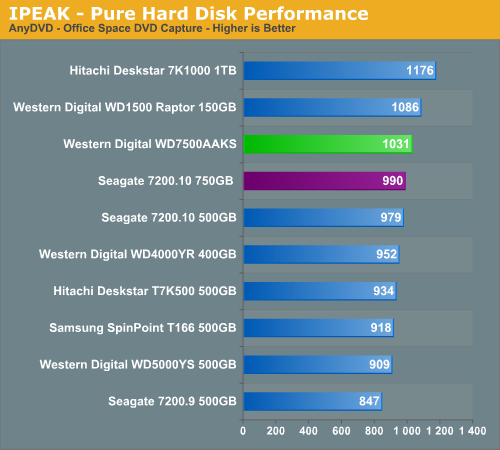
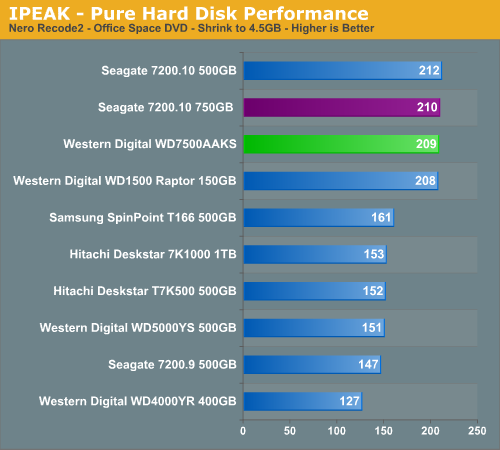
The AnyDVD benchmark is heavily weighted to sequential write requests with the PMR based drives generally finishing ahead of the other 7200RPM drives. The Western Digital drive beats the Seagate 7200.10 in this benchmark by nearly 4%, and even comes close to the vaunted Raptor. All non-PMR drives in the benchmark fall further behind the WD7500AAKS, generally moving well into the double-digit percentage differences. (Higher data density means faster transfer rates, which is part of the reason the PMR drives do so well.)
The Nero Recode 2 benchmark is weighted to streaming read requests but is balanced by continuous write operations near the end of the test. In this assessment, the Seagate 7200.10 edges out the WD7500AAKS slightly, which in turn comes in slightly ahead of the WD Raptor. Other non-PMR disks fall far behind in this benchmark. Realistically, the three drives at the top of this chart can be considered equal in this kind of task given the modest numerical difference in scores between each drive.
iPEAK Game Installation Tests
Our iPEAK based Game Installation benchmarks simply show the ability of the hard drive to write data as quickly as possible to the disc based upon the installation software instructions. As detailed in our iPEAK setup description we installed the games from our source drive in order to eliminate the optical drive bottleneck. In separate application timing we witnessed basically the same percentage spread when installing the games via our DVD drive so these results are representative of actual installation performance.
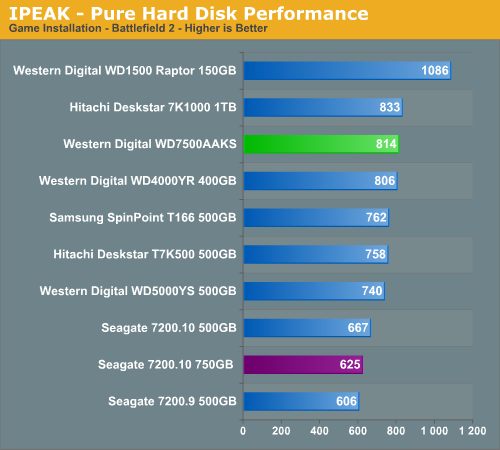
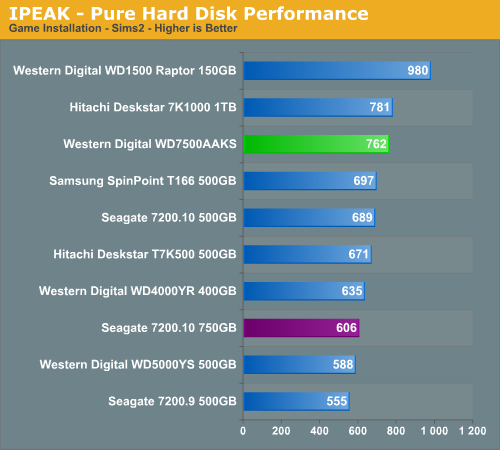
The Raptors, as expected, dominates our gaming tests due to their rotational and random access speed advantages. The WD7500AAKS turns in third-place finishes in both of these tests, behind the speedy Hitachi 7K1000 drive and lightning fast Raptors. Of note, the difference in performance between Western Digital's 750GB offering and Seagate's 7200.10 750GB drive is roughly 15% in each case.
iPEAK Game Play Tests
The iPEAK based Game Play tests are centered on the benefits of having a hard disk that can load non-linear or sequential data files quickly without interrupting the flow of the game.
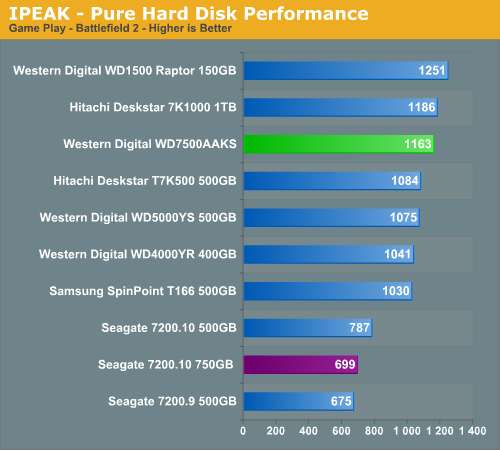
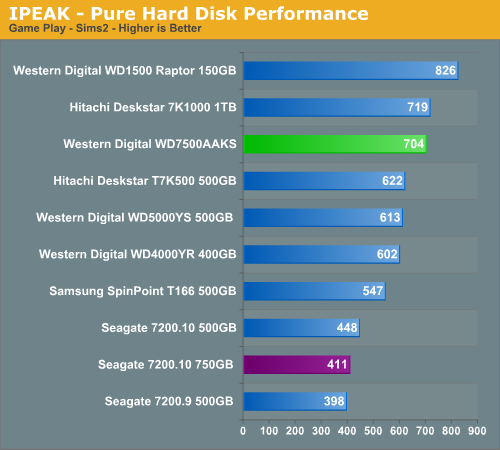
In a virtual copy of the results from the iPEAK Game Installation tests, the Western Digital WD7500AAKS comes in third, behind the Raptor and the Hitachi 7K1000. The difference between the Western Digital drive and the Seagate 750GB drive has become a chasm, benchmarking at a roughly 35% differential.
We need to remember our iPEAK tests reflect pure hard drive performance and will be mitigated by the system platform components as we will see in our application tests.
The iPEAK based Video/Audio benchmarks are designed around simulating media encoding and HTPC activities. These benchmarks are CPU intensive in nature but also require a balanced storage system with the ability to handle read and write requests simultaneously in a very efficient manner. Using iPEAK also effectively removes the CPU from the equation, allowing us to focus on the hard drives.


The AnyDVD benchmark is heavily weighted to sequential write requests with the PMR based drives generally finishing ahead of the other 7200RPM drives. The Western Digital drive beats the Seagate 7200.10 in this benchmark by nearly 4%, and even comes close to the vaunted Raptor. All non-PMR drives in the benchmark fall further behind the WD7500AAKS, generally moving well into the double-digit percentage differences. (Higher data density means faster transfer rates, which is part of the reason the PMR drives do so well.)
The Nero Recode 2 benchmark is weighted to streaming read requests but is balanced by continuous write operations near the end of the test. In this assessment, the Seagate 7200.10 edges out the WD7500AAKS slightly, which in turn comes in slightly ahead of the WD Raptor. Other non-PMR disks fall far behind in this benchmark. Realistically, the three drives at the top of this chart can be considered equal in this kind of task given the modest numerical difference in scores between each drive.
iPEAK Game Installation Tests
Our iPEAK based Game Installation benchmarks simply show the ability of the hard drive to write data as quickly as possible to the disc based upon the installation software instructions. As detailed in our iPEAK setup description we installed the games from our source drive in order to eliminate the optical drive bottleneck. In separate application timing we witnessed basically the same percentage spread when installing the games via our DVD drive so these results are representative of actual installation performance.


The Raptors, as expected, dominates our gaming tests due to their rotational and random access speed advantages. The WD7500AAKS turns in third-place finishes in both of these tests, behind the speedy Hitachi 7K1000 drive and lightning fast Raptors. Of note, the difference in performance between Western Digital's 750GB offering and Seagate's 7200.10 750GB drive is roughly 15% in each case.
iPEAK Game Play Tests
The iPEAK based Game Play tests are centered on the benefits of having a hard disk that can load non-linear or sequential data files quickly without interrupting the flow of the game.


In a virtual copy of the results from the iPEAK Game Installation tests, the Western Digital WD7500AAKS comes in third, behind the Raptor and the Hitachi 7K1000. The difference between the Western Digital drive and the Seagate 750GB drive has become a chasm, benchmarking at a roughly 35% differential.
We need to remember our iPEAK tests reflect pure hard drive performance and will be mitigated by the system platform components as we will see in our application tests.










37 Comments
View All Comments
retrospooty - Thursday, August 9, 2007 - link
"There seems very little reason to even consider a Raptor anymore. "Except for hte fact that the Raptor 150 is 1 1/2 years old (thats older than the 7200.10 you mentioned) and a 300g Raptor, hopefully with 32m cache is also right around the corner. A300g Raptor with 32m cache will once again own the retail sector by a wide margin.
mostlyprudent - Thursday, August 9, 2007 - link
It will be interesting to see what new Raptor with 32MB of cache can do. I am still skeptical whether it will be able to manage the kind of performance advantage the Raptors had when they were first introduced. I personally think WD will have a tough time charging a significant price premium over other 300GB drives, let alone 750GB and 1TB drives.yyrkoon - Monday, August 13, 2007 - link
You mean the 'whopping' 58MB/s average ? The raptors when first released had issues. Less so now, and they perform much better. Not good enough to justify the cost in my opinion, but whatever floats your boat . . .
ceefka - Friday, August 10, 2007 - link
The Raptor would need more than 32MB cache to get (far) ahead of the pack again, like it did when it was first introduced. Three things they can do:1. Higher density platter :perpendicular
2. 15K rpm? I don't even know if that is possible, but it would be cool.
3. Like you said: 32MB or even more cache.
Martimus - Wednesday, August 15, 2007 - link
The higher density would slow it down, because the heads would need to be more precise. I think that is why the raptors always have less capacity than their caviar brand.retrospooty - Friday, August 10, 2007 - link
Right now the Raptor 150 is ahead of the pack with 16m cache vs 32, and a much lower density per platter, and no perpendicular storage. Add those 3 things and we might be cooking. I have heard rumors that 15k is in the works, but not confirmed.Basilisk - Thursday, August 9, 2007 - link
Or, you may need something loud enough to drown-out your partner's snoring. :)yyrkoon - Monday, August 13, 2007 - link
Funny that, I own a 750GB Seagate, the computer sits less than 4 feet from my head when I sleep up on a desk, and I cannot hear it. Now, If it were not the end of summer, and I were not living in the desert, had all my fans off, I MAY hear the occational disk chatter, but I'll be dahmed if it would ever keep me awake . . .Sometimes I wonder about some of you guys . . .
retrospooty - Thursday, August 9, 2007 - link
??? I dunno. I see AT's comparison always has the Raptor being loud, but I hafve had 1 36g 2 75g and 2 150g Raptors, none of them have been noisy at all, not even compared to other drives. Was I just lucky or is AT's samples unlucky?semo - Thursday, August 9, 2007 - link
is there a difference between the serial ata and the pata se16 wd drives?